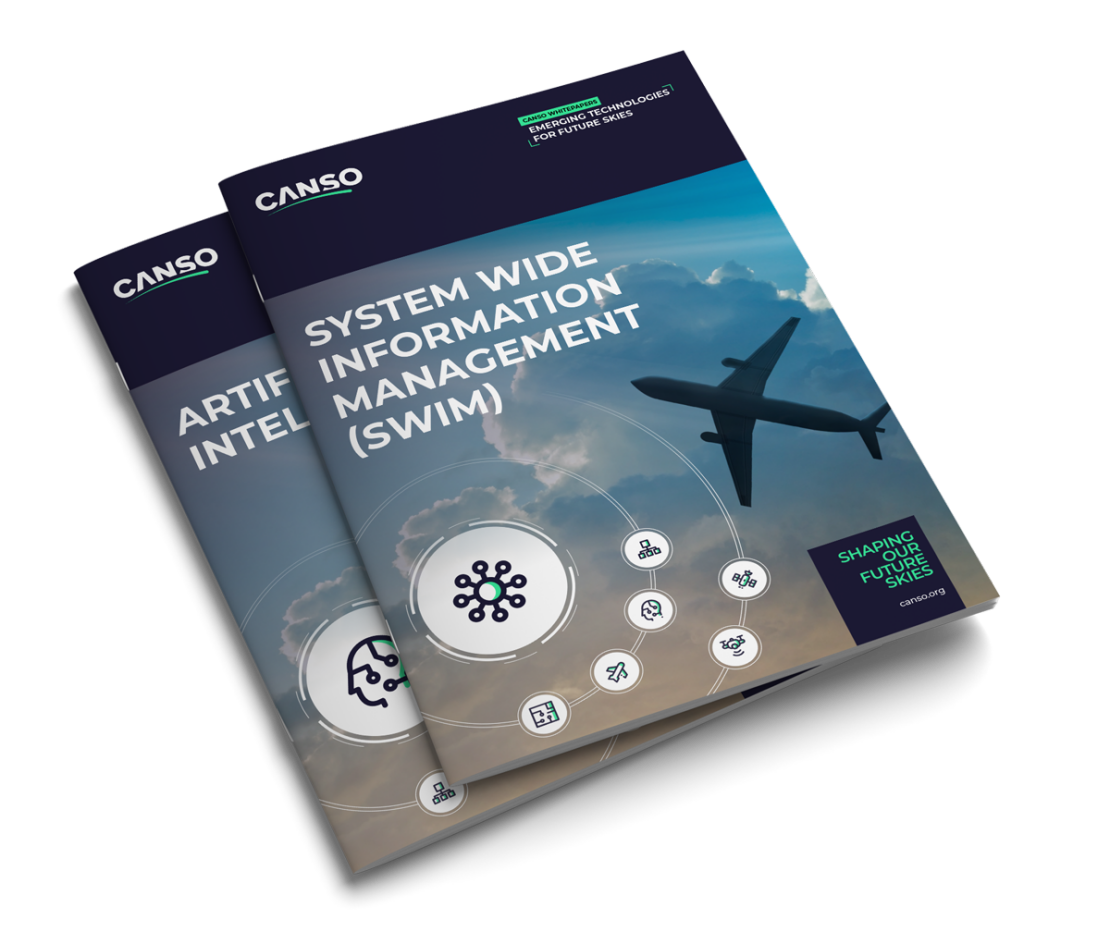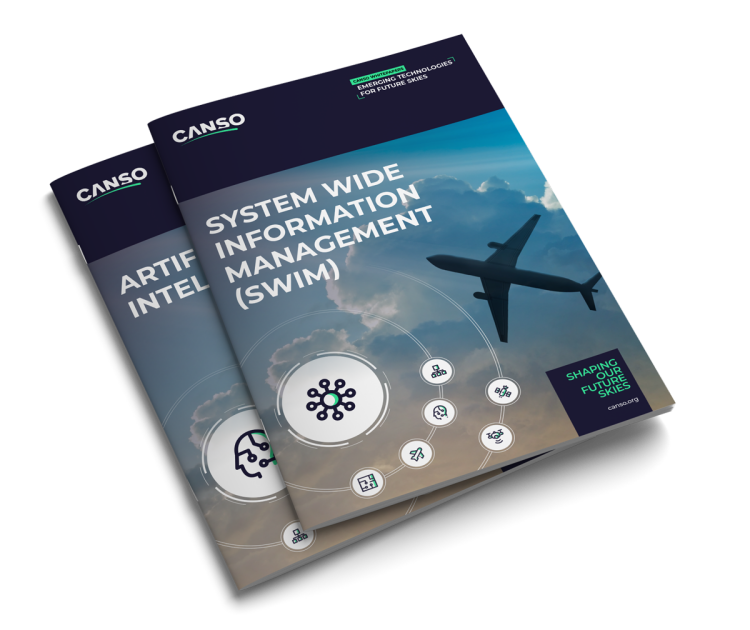System-wide information management is a step-change for the industry and CANSO is determined to facilitate implementation.


Airspace Article


Providing enterprise-level capabilities and new opportunities for new entrants to operate safely
Supporting the development and adoption of a global aviation language
Creating collaboration opportunities across international borders and within the industry to address some of aviation’s most complex problems
Reducing implementation and operating costs while increasing the ability of the air traffic community to be more productive
Increasing efficiency in sharing and obtaining data
Using the minimum viable compliant implementation while maintaining a path to a broader implementation in the future
The latest whitepaper from the CANSO Strategic Technology Workgroup (STWG) on system-wide information management (SWIM) attempts to provide clarity and impetus to this important initiative.
It has to be acknowledged that SWIM has not progressed as quickly as hoped. Once a Block 0 or Block 1 development according to ICAO’s Aviation System Block Upgrades (ASBU), SWIM has slipped to Block 2 or 3, putting the timeframe at 2025 or beyond. Complications include data access, data ownership, intellectual property protection, and procurement.
The whitepaper identifies the roadblocks to SWIM implementation and possible solutions.


One issue raised by air navigation service providers (ANSPs) is that cost benefit analyses do not easily justify the expense. But often this can be down to an overly broad general SWIM solution that goes beyond the targeted operational efficiency or problem to be solved. The problem is amplified if only inter-ANSP SWIM exchanges are considered and if a legacy system must be maintained even once the SWIM system has been implemented.
The whitepaper suggests that “both traditional and new airspace users should be included in any business case as the ANSP may not be the only recipient of benefits”. Also, many SWIM benefits cannot be fully realised with ANSP exchanges. “SWIM is an enabler, and a fair business case considers all applicable and relevant enabled operational improvements,” states the paper.
Another challenge is the prescriptive SWIM governance, which can be seen as constraining rather than supportive of the innovative spirit. But governance does have a formal role to play in supporting the standards that enable interoperability. The cost of an ungoverned SWIM implementation, such as non-compliance with, or lack of, standards may lead to needless effort and the disruption of business processes, ultimately resulting in more costs.
Related to this is the amount of guidance and information available, which leads to an assumption that a large expensive system is always required. The CANSO SWIM Workgroup is looking at this issue alongside the SWIM Task Force and other organisations across aviation, such as the FAA and EUROCONTROL. Often, a simple solution will suffice so SWIM does not necessarily mean a large expense.
Costly exercise
“Both traditional and new airspace users should be included in any business case as the ANSP may not be the only recipient of benefits, SWIM is an enabler, and a fair business case considers all applicable and relevant enabled operational improvements”
Emerging technologies for future skies:
System Wide Information Management (SWIM)
There is little doubt that SWIM comes with a range of benefits whether it is used to address a particular problem, such as ground delay, or replaces an entire legacy system, resulting in higher capacity, greater efficiency and cost reduction.
There are already some notable trials and success stories. A SWIM trial by the Association of South-East Asian Nations (ASEAN) focused on exchanging information for operational benefits. It presented proposals for different architectures based on how an ANSP can utilise both the Common aeronautical Virtual (CRV) private network and other networks such as the public internet for inter-ANSP communication.
SWIM is also one of the main initiatives in Japan’s Collaborative Actions for Renovation of Air Traffic Systems (CARATS) programme. The Japan Civil Aviation Bureau (JCAB) plans to implement SWIM in 2024 to replace existing system point-to-point connections using outdated technologies. The goal is to provide data services and web services that facilitate the use of aeronautical information and flight information to aviation stakeholders.
Achieving success
Considering the wider aviation market and reviewing potential opportunities for additional revenue that could be derived from data exploitation
Developing and supporting a regional Community of Interest for the ANSPs, airports, airlines, suppliers and their engineers, data scientists and operational experts
Using this community to better articulate the problem to be solved and recognise the different SWIM governance approaches to be taken on a region-by-region basis
Designing a consistent set of principles, rules, processes and structure to facilitate SWIM implementation
Collaborating with a regional or industry partner – as it may be more effective to reuse and integrate than procure a stand-alone capability. A register of industrial solutions and SWIM compatible implementations may be useful for ANSP discovery and market investigation

Considering non-safety-critical use cases first and starting small
Analysing the local system infrastructure and trying to identify which parts could be improved by SWIM concepts
Talking to system vendors to find out what additional SWIM services are on the product roadmaps that would enhance the local system infrastructure
Engaging with SWIM through the CANSO Workgroup or the regional ICAO office
The main issue is that if SWIM continues to be adopted at this pace, new services such as Unmanned Aerial Systems Traffic Management (UTM) may become decoupled from ANSP progress. SWIM adoption must accelerate if ANSPs do not want to maintain duplicate or multi-tier systems.
The experts and ANSPs that contributed to the CANSO whitepaper make a list of suggestions about how the SWIM implementation challenge can be overcome. These include:
The main issue is that if SWIM continues to be adopted at this pace, new services such as Unmanned Aerial Systems Traffic Management (UTM) may become decoupled from ANSP progress. SWIM adoption must accelerate if ANSPs do not want to maintain duplicate or multi-tier systems.
The experts and ANSPs that contributed to the CANSO whitepaper make a list of suggestions about how the SWIM implementation challenge can be overcome. These include:
Solutions
Making interfaces available through SWIM facilitates the exchange of data and enables the automation of processes. It is an information-centric approach that leads to better service at lower cost. Moreover, the wide use of big data triggers innovation – especially in safety – and offers additional non-safety critical revenue opportunities.
The whitepaper additionally points out that SWIM benefits others besides ANSPs. It allows non-traditional players to enter the market contributing to the creation of jobs, for example.
SWIM programmes have focused on:
Perhaps most important of all is to run a thorough cost/benefit analysis to discover the likely expense and the operational and business advantages.

SWIM definition
Airspace Article

Read full article

Lorem ipsum dolor sit amet, consectetur adipiscing elit. Praesent venenatis mi massa, quis ultrices lacus commodo a
Airspace Article


Using this community to better articulate the problem to be solved and recognise the different SWIM governance approaches to be taken on a region-by-region basis
One issue raised by air navigation service providers (ANSPs) is that cost benefit analyses do not easily justify the expense. But often this can be down to an overly broad general SWIM solution that goes beyond the targeted operational efficiency or problem to be solved. The problem is amplified if only inter-ANSP SWIM exchanges are considered and if a legacy system must be maintained even once the SWIM system has been implemented.
The whitepaper suggests that “both traditional and new airspace users should be included in any business case as the ANSP may not be the only recipient of benefits”. Also, many SWIM benefits cannot be fully realised with ANSP exchanges. “SWIM is an enabler, and a fair business case considers all applicable and relevant enabled operational improvements,” states the paper.
Another challenge is the prescriptive SWIM governance, which can be seen as constraining rather than supportive of the innovative spirit. But governance does have a formal role to play in supporting the standards that enable interoperability. The cost of an ungoverned SWIM implementation, such as non-compliance with, or lack of, standards may lead to needless effort and the disruption of business processes, ultimately resulting in more costs.
Related to this is the amount of guidance and information available, which leads to an assumption that a large expensive system is always required. The CANSO SWIM Workgroup is looking at this issue alongside the SWIM Task Force and other organisations across aviation, such as the FAA and EUROCONTROL. Often, a simple solution will suffice so SWIM does not necessarily mean a large expense.
Costly exercise
The latest whitepaper from the CANSO Strategic Technology Workgroup (STWG) on system-wide information management (SWIM) attempts to provide clarity and impetus to this important initiative.
It has to be acknowledged that SWIM has not progressed as quickly as hoped. Once a Block 0 or Block 1 development according to ICAO’s Aviation System Block Upgrades (ASBU), SWIM has slipped to Block 2 or 3, putting the timeframe at 2025 or beyond. Complications include data access, data ownership, intellectual property protection, and procurement.
The whitepaper identifies the roadblocks to SWIM implementation and possible solutions.
There is little doubt that SWIM comes with a range of benefits whether it is used to address a particular problem, such as ground delay, or replaces an entire legacy system, resulting in higher capacity, greater efficiency and cost reduction.
There are already some notable trials and success stories. A SWIM trial by the Association of South-East Asian Nations (ASEAN) focused on exchanging information for operational benefits. It presented proposals for different architectures based on how an ANSP can utilise both the Common aeronautical Virtual (CRV) private network and other networks such as the public internet for inter-ANSP communication.
SWIM is also one of the main initiatives in Japan’s Collaborative Actions for Renovation of Air Traffic Systems (CARATS) programme. The Japan Civil Aviation Bureau (JCAB) plans to implement SWIM in 2024 to replace existing system point-to-point connections using outdated technologies. The goal is to provide data services and web services that facilitate the use of aeronautical information and flight information to aviation stakeholders.
Achieving success
Other important lessons from the pandemic include:
Providing enterprise-level capabilities and new opportunities for new entrants to operate safely
Supporting the development and adoption of a global aviation language
Creating collaboration opportunities across international borders and within the industry to address some of aviation’s most complex problems
Reducing implementation and operating costs while increasing the ability of the air traffic community to be more productive
Increasing efficiency in sharing and obtaining data
Making interfaces available through SWIM facilitates the exchange of data and enables the automation of processes. It is an information-centric approach that leads to better service at lower cost. Moreover, the wide use of big data triggers innovation – especially in safety – and offers additional non-safety critical revenue opportunities.
The whitepaper additionally points out that SWIM benefits others besides ANSPs. It allows non-traditional players to enter the market contributing to the creation of jobs, for example.
The main issue is that if SWIM continues to be adopted at this pace, new services such as Unmanned Aerial Systems Traffic Management (UTM) may become decoupled from ANSP progress. SWIM adoption must accelerate if ANSPs do not want to maintain duplicate or multi-tier systems.
The experts and ANSPs that contributed to the CANSO whitepaper make a list of suggestions about how the SWIM implementation challenge can be overcome. These include:
Solutions
Considering the wider aviation market and reviewing potential opportunities for additional revenue that could be derived from data exploitation
Developing and supporting a regional Community of Interest for the ANSPs, airports, airlines, suppliers and their engineers, data scientists and operational experts
Designing a consistent set of principles, rules, processes and structure to facilitate SWIM implementation

Using the minimum viable compliant implementation while maintaining a path to a broader implementation in the future
Collaborating with a regional or industry partner – as it may be more effective to reuse and integrate than procure a stand-alone capability. A register of industrial solutions and SWIM compatible implementations may be useful for ANSP discovery and market investigation
Considering non-safety-critical use cases first and starting small
Analysing the local system infrastructure and trying to identify which parts could be improved by SWIM concepts
Talking to system vendors to find out what additional SWIM services are on the product roadmaps that would enhance the local system infrastructure
Engaging with SWIM through the CANSO Workgroup or the regional ICAO office
Perhaps most important of all is to run a thorough cost/benefit analysis to discover the likely expense and the operational and business advantages.
SWIM definition
The whitepaper acknowledges that SWIM “means different things to different people across the …world of aviation”.
It defines SWIM as “standards, infrastructure and governance enabling the management of ATM-related information and its exchange between qualified parties via interoperable services.”

Airspace Article